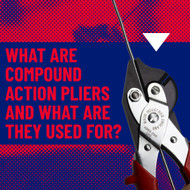What Are Compound Action Pliers And What Are They Used For?
12th Mar 2024
A compound action plier multiplies your hand force to give you increased cutting power or increased grip.
Learn how they work and what they’re used for below.
What are compound action pliers?
Compound-lever action pliers are similar to traditional pliers, but they use multiple pivot points to create extra leverage, resulting in what’s known as a “mechanical advantage”.
This increased leverage helps to increase their gripping strength and cutting force, making them essential when dealing with heavy or tough materials.
In high repetition applications that may tire your hands, or where larger, longer-handled tools might be needed to cut harder materials, compound action pliers allow you to complete the job more efficiently.
Examples of good compound action pliers
Here are two good examples of compound action cutting pliers, both of which meet the standards BS 3087-7:1996 and ISO 5747:1995.
Maun Diagonal Cutting Pliers
Here, you can see a classic 2-lever compound action system that multiplies the hand force twice, first through the handles, and then through the pivot of the scissor-action jaws of the plier. This greatly increases the force that is output on the cutter side.
This specific model is designed to cut through hard wire with ease and uses induction-hardened cutting jaws shaped for durability and accuracy.
You can shop this range here.
Maun Side Cutter Parallel Pliers
These pliers have a slightly different compound-lever system, which operates the cutting jaws in conjunction with gripping jaws that close in parallel instead of as a scissor-action.
They have multiple benefits, leaving the gripping jaws with an uninterrupted surface that grips evenly along the length, and allows materials to pass through the throat of the plier.
This also means that the compound-lever action cutter is not positioned behind the gripping jaws and is more accessible, making it an excellent multi-use combination plier.
You can shop this range here.
Practical benefits: when are they used?
Maintenance & Repair Work
MRO engineers often face cutting through thick wire and trunking which can be both time-consuming and physically demanding.
Conventional cutting pliers may lack the leverage to do this, meaning it may take multiple cuts and leave an inaccurate or messy finish. This may require additional work to complete the job to an acceptable standard.
In contrast, compound action pliers will cut through more difficult materials in one pass which could mean that the cutters are smaller and lighter, to reduce the load that is carried in a maintenance tool kit.
Model Making
For larger models, hard wire may be used to provide structure and strength, either as a skeleton around which a surface is created or as reinforcement linking sections of a model together.
Traditional cutting pliers may be unable to cut the hard wire or may quickly induce strain and fatigue where lots of cuts are required.
By using a compound-lever action cutting plier, the effort needed to make a cut is less, and harder materials can be cut, reducing the fatigue experienced by a model maker.
Jewellery Making & Horology
When you’re making fine cuts to a piece of jewellery, you need to be incredibly delicate in how you work, often with a pair of flush-cut pliers.
Where larger diameter, or harder material is being used, for example brass used in watch and clock making, flush cut and even regular diagonal cutting pliers may not have the capacity to cut the material. This can result in damage to the cutting edges or user fatigue, both of which can lead to poor results with expensive materials.
Contrast that with compound action pliers, where hardened cutting edges and the mechanical advantage of the design, mean that cutting much larger or harder materials can be made with less effort. This helps to make cuts easier and cleaner, reducing the work required to achieve the perfect finished product.
Conclusion
You now know all about the features and benefits of choosing compound action pliers for your next project.
If you have any feedback or improvements you’d recommend for this post, we’d love to hear from you.
This post was brought to you by Maun, experts in tools since 1944.
Scroll back up to re-read any key points, browse our related pages below, or contact us with any questions:



